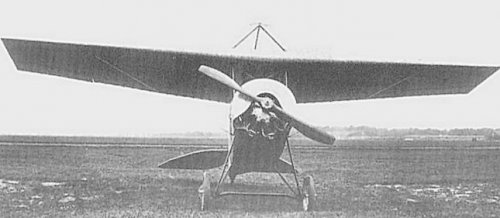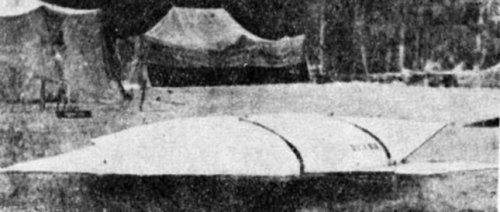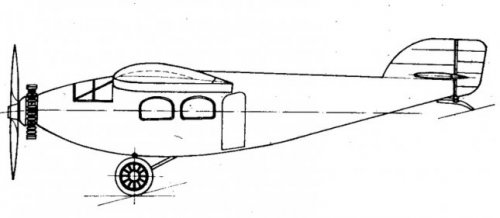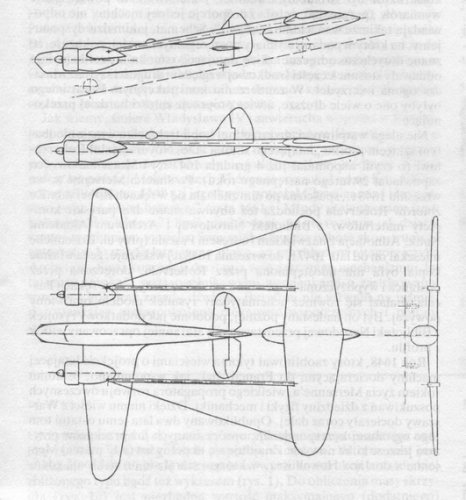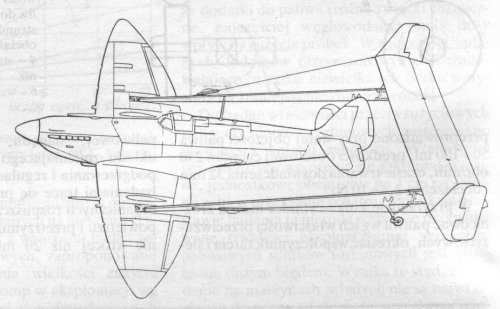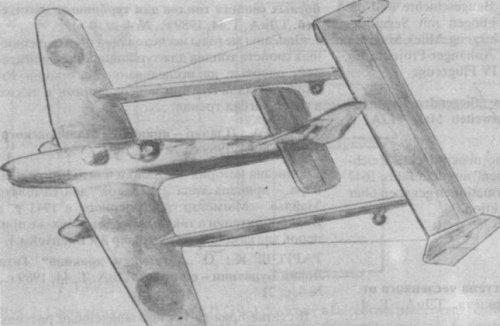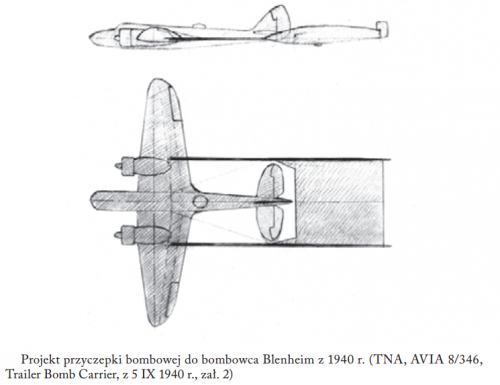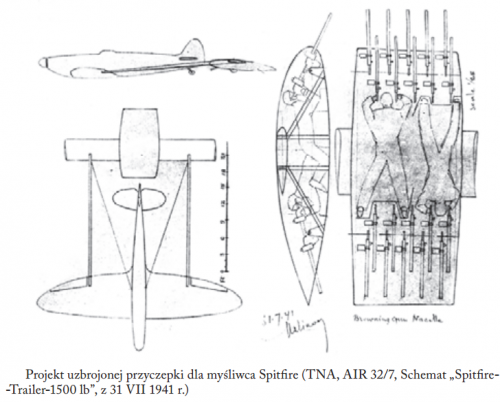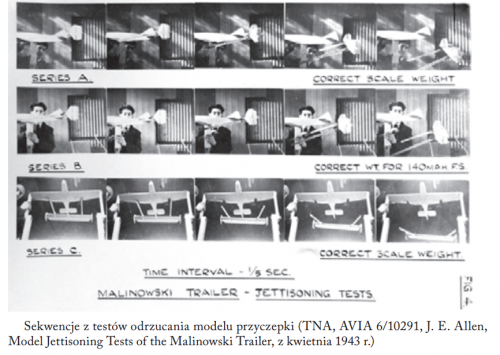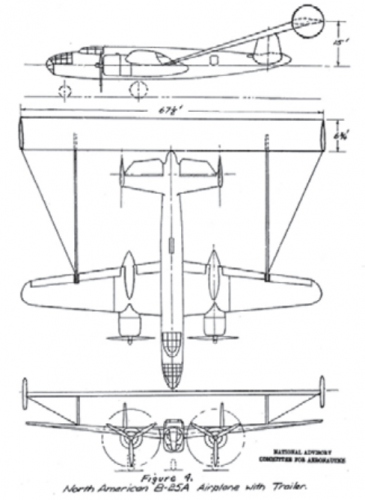Raw Google Translate output:
Malinowski- glider trailer, 1941
Glider trailer. Poland / Great Britain.
In September 1940, Major Eng. Stefan Malinowski submitted to the Inspectorate of the Polish Air Force in Great Britain a project of a glider trailer for combat aircraft. He developed her idea in the years 1936-1939 in Poland. The task of the glider trailer in the form of a wing pulled by the plane on booms was to increase the load carried by the plane by 100-200%, which allowed either to increase the load of bombs or goods, or to take more fuel, i.e. to increase the range of the plane, or to partially increase both . The increase in load was carried out with an unincorporated number of the crew, in contrast to the towing of the transport glider. The cost of building the trailer was many times lower than the cost of building an airplane or a glider, and the construction was much simpler and faster. The trailer design was accepted for implementation by the Air Ministry and in January 1941, Eng. S. Malinowski was appointed to the Royal Aeronautical Establishment (RAE) in Farnborough to work on his idea. A model for aerodynamic tests was made and preliminary aerodynamic tests were carried out in 1941.
To test the idea, S. Malinowski developed the construction of an experimental trailer for the Miles M.14 "Magister" training aircraft. The trailer was a rectangular wing with two outriggers (so-called drawbars), which were connected to the plane with articulated joints allowing for vertical movement. In August 1941, trailer tests were carried out in Farnborough. During the run-up, the trailer changed the direction of flight and rolled on one wheel. The shocks of the trailer chassis were transferred to the beams (drawbars), causing vibrations of the aircraft wings. During the tests, the rudder area of the aircraft was increased by 30%, but it turned out to be insufficient. Erecting the team was no different from erecting the plane itself. As a result of these tests, it was found necessary to redesign the trailer.
Due to other urgent work at the RAE, in September 1941 the work and alterations were suspended by the English. Mr. S. Malinowski was referred to the Polish Military Institute of Technology (WIT) in order to continue work on the trailer. In December 1941, a group of constructors working on the issue of air transport was established at the BTI Aviation Technology Section (headed by Maj. Eng. Jan Żardecki), which included: Eng. Jerzy Dąbrowski, pil. Włodzimierz Polny and 2nd Lt. Adam Ścibor-Rylski. From September 1941 to March 1942, Eng. S. Malinowski developed the assembly drawings of a trailer with a rectangular and trapezoidal wing, as well as drawings of the connection of the wing with the drawbar, landing gear, ballast and rudder, connection of the drawbar with the wing of the aircraft (using a serial electric ejector to eject the trailer), automatic rudder drive and automatic launch mechanism the trailer's flaps at take-off in the event of overloading the wing with a load.
The proposed construction group was to develop a trailer for the Supermarine "Spitfire" Mk.VIII fighter aircraft within 6 months, allowing them to take 900 kg of bombs or 450 kg of fuel and 450 kg of bombs, which extended the flight time by 2 hours and the range by 800 km. The next project was to be a trailer for a Bristol 142 "Blenheim" bomber taking 1,800 kg of bombs (the plane took 450 kg) or increasing the flight time by 2 hours, or a trailer for a Douglas "Boston" plane or four-engine Handley Page HP.57 "Halifax" planes or Avro 683 "Lancaster" (trailer carrying 7,200 kg of load).
In March 1942, work on the trailer was resumed in Farnborough, with some structural corrections and subsequent tests. On March 26, 1942, the tests were completed. On April 13, 1942, a demonstration flight of the trailer for the Inspector of the Polish Air Force, Brig. Gen. pil. S. Ujejski. In May 1942, the English drafted and gave up on this subject. In 1942, S. Malinowski repeated his proposals to return to the construction of a trailer for one of the combat aircraft. On January 15, 1943, the Air Ministry agreed to make the project available to the American aviation authorities. In March 1943, the British Ministry of Aviation Industry announced that the trailer for the "Spitfire" was too complicated, no further work was undertaken.
Design, experimental trailer for the Miles M.14 "Magister" plane:
It was a rectangular wing with two outriggers (so-called drawbars), which were connected to the plane with articulated joints that allowed for movement in the vertical plane. There are wheels under the beams, and a vertical tail at the ends of the wings. Wooden construction. The beams were stiffened in the horizontal plane with the lines running to the fins. As a load, 2 bombs were hung in the symmetry axis of the trailer or at the ends of the wing. Bomb capacity - 250 kg.
Technical data, experimental trailer for the Miles M.14 "Magister" plane (according to [1]):
Span - 7.62 m, bearing area - 11.5 m2.
Own weight - 70 kg, weight with bombs - 336 kg.
Technical data, trailer for the "Blenheim" Mk IV plane (according to [1]):
Span - 14.3 m, wing chord max - 3.65 m, drawbar length - 11 m, fuselage length - 5.5 m, total length - 15.2 m, minimum wing chord - 1.07 m, bearing surface - 33.5 m2.
Sources:
[1] Glass A. "Stefan Malinowski's Glider Trailer". Military aircraft of the world 1935-1945.
[2] Morgała A. "Polish military planes 1939-1945". Publishing House of the Ministry of National Defense. Warsaw 1976.
[3] Glass A. "S. Malinowski's glider trailer". Aviation and Astronautics Technique No. 4/1989.
[4] Collective work "Polish technical thought in the Second World War, on the 70th anniversary of the end of hostilities in Europe". Central Military Library of Marshal Józef Piłsudski. Warsaw 2015.
I don't know which, if any, of theose sources are actually English-language, so here they are in the original Polish:
[1] Glass A. ”Przyczepka szybowcowa Stefana Malinowskiego”.
Samoloty wojskowe świata 1935-1945.
[2] Morgała A. ”Polskie samoloty wojskowe 1939-1945”. Wydawnictwo MON. Warszawa 1976.
[3] Glass A. "Przyczepka szybowcowa S. Malinowskiego". Technika Lotnicza i Astronautyczna nr 4/1989.
[4] Praca zbiorowa"Polska myśl techniczna w II wojnie światowej w 70. rocznicę zakończenia działań wojennych w Europie". Centralna Biblioteka Wojskowa im. Marszałka Józefa Piłsudskiego. Warszawa 2015.

